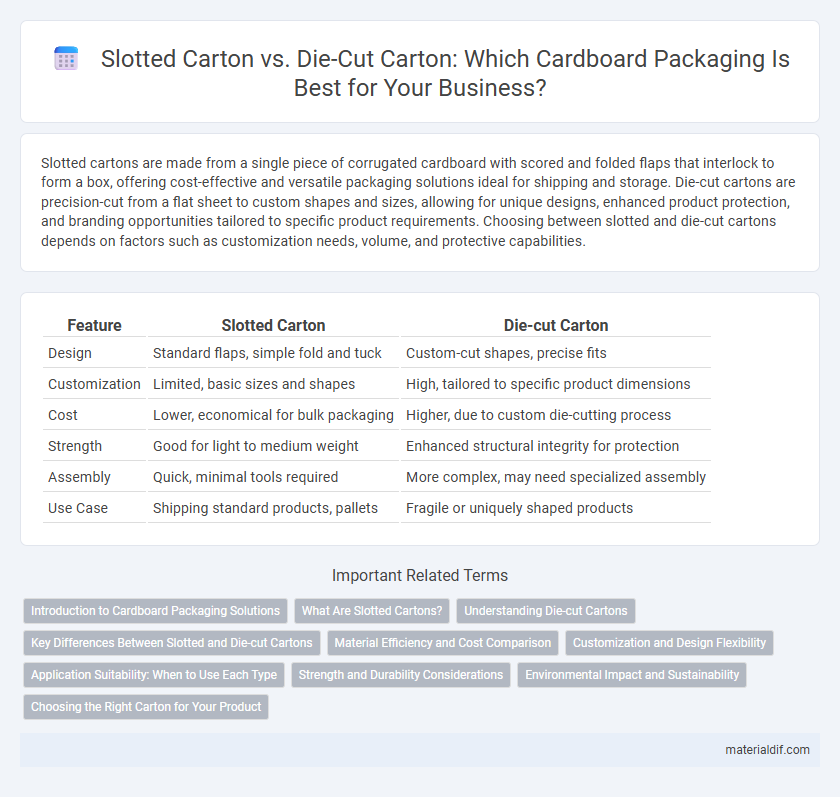Slotted cartons are made from a single piece of corrugated cardboard with scored and folded flaps that interlock to form a box, offering cost-effective and versatile packaging solutions ideal for shipping and storage. Die-cut cartons are precision-cut from a flat sheet to custom shapes and sizes, allowing for unique designs, enhanced product protection, and branding opportunities tailored to specific product requirements. Choosing between slotted and die-cut cartons depends on factors such as customization needs, volume, and protective capabilities.
Table of Comparison
| Feature | Slotted Carton | Die-cut Carton |
|---|---|---|
| Design | Standard flaps, simple fold and tuck | Custom-cut shapes, precise fits |
| Customization | Limited, basic sizes and shapes | High, tailored to specific product dimensions |
| Cost | Lower, economical for bulk packaging | Higher, due to custom die-cutting process |
| Strength | Good for light to medium weight | Enhanced structural integrity for protection |
| Assembly | Quick, minimal tools required | More complex, may need specialized assembly |
| Use Case | Shipping standard products, pallets | Fragile or uniquely shaped products |
Introduction to Cardboard Packaging Solutions
Slotted cartons feature pre-scored panels that fold together, providing a cost-effective and versatile solution for cardboard packaging. Die-cut cartons are custom-designed with intricate shapes and cutouts, offering enhanced branding and structural features tailored to specific products. Both options deliver efficient protection and sustainability, catering to diverse packaging needs in industries ranging from retail to shipping.
What Are Slotted Cartons?
Slotted cartons are a popular type of cardboard packaging characterized by their simple design with four flaps on the top and bottom that create a rectangular box when folded and sealed. They are typically used for shipping and storage because of their cost-effectiveness, easy assembly, and structural strength. Unlike die-cut cartons that are custom-shaped for specific products, slotted cartons are versatile and can accommodate various items with standard dimensions.
Understanding Die-cut Cartons
Die-cut cartons are precisely engineered using custom-cut shapes and intricate patterns to provide enhanced structural integrity and unique design options compared to standard slotted cartons. These cartons allow for tailored features such as handles, windows, and locking tabs, optimizing both aesthetics and functionality. Understanding die-cut cartons involves recognizing their versatility in branding opportunities and superior protection for delicate or irregularly shaped products.
Key Differences Between Slotted and Die-cut Cartons
Slotted cartons feature flaps that fold and interlock for assembly, providing cost-effective and versatile packaging suitable for shipping and storage. Die-cut cartons are custom-shaped with precise cuts and designs, offering enhanced protection and branding opportunities for high-value or irregularly shaped products. The key differences lie in manufacturing complexity, structural design, and application, with slotted cartons emphasizing simplicity and die-cut cartons prioritizing customization and presentation.
Material Efficiency and Cost Comparison
Slotted cartons use pre-scored cardboard sheets folded and secured with tape or glue, offering higher material efficiency with minimal waste due to standardized flat patterns. Die-cut cartons require custom cutting and creasing, leading to increased material waste and higher production costs but provide more precise dimensions and enhanced structural integrity. While slotted cartons are cost-effective for bulk packaging, die-cut cartons are preferable for specialized applications where durability and design customization justify the additional expense.
Customization and Design Flexibility
Slotted cartons offer basic customization with standard slot designs, making them ideal for straightforward packaging needs. Die-cut cartons provide superior design flexibility through tailored cuts and intricate shapes, enabling unique branding and specialized functionality. This customization advantage makes die-cut cartons preferable for products requiring distinctive visual appeal and precise fit.
Application Suitability: When to Use Each Type
Slotted cartons are ideal for bulk storage and shipping due to their straightforward design and ease of assembly, making them suitable for industries requiring quick packaging solutions such as e-commerce and food distribution. Die-cut cartons offer precise shapes and specialized features, providing enhanced protection and branding opportunities, which are best for high-end retail packaging and fragile products. Choosing between slotted and die-cut cartons depends on product fragility, branding needs, and packaging complexity.
Strength and Durability Considerations
Slotted cartons feature pre-cut flaps that fold together, offering moderate strength suitable for lightweight packaging, while die-cut cartons are custom-shaped from a single piece, providing superior durability and structural integrity for heavy or delicate items. Die-cut cartons reduce the need for additional supports or fillers, enhancing protection during transit and stacking. Strength assessments often favor die-cut designs for their ability to withstand compression and impacts, making them ideal for high-value or fragile goods requiring robust packaging solutions.
Environmental Impact and Sustainability
Slotted cartons, made from corrugated cardboard, are easier to recycle due to their simple design and minimal use of adhesives, reducing environmental waste. Die-cut cartons often involve complex cutting and additional coatings or laminates that hinder recyclability and increase carbon footprint during production. Choosing slotted cartons supports sustainability efforts by promoting efficient recycling and lowering material waste compared to die-cut alternatives.
Choosing the Right Carton for Your Product
Slotted cartons are ideal for straightforward packaging needs due to their simple design, cost-efficiency, and ease of assembly, making them perfect for bulk shipping and storage. Die-cut cartons offer precise shapes and custom features tailored to product dimensions, enhancing protection and presentation, especially for fragile or uniquely shaped items. Selecting the right carton depends on balancing cost, product fragility, and branding requirements to ensure optimal protection and customer appeal.
Slotted carton vs Die-cut carton Infographic

 materialdif.com
materialdif.com